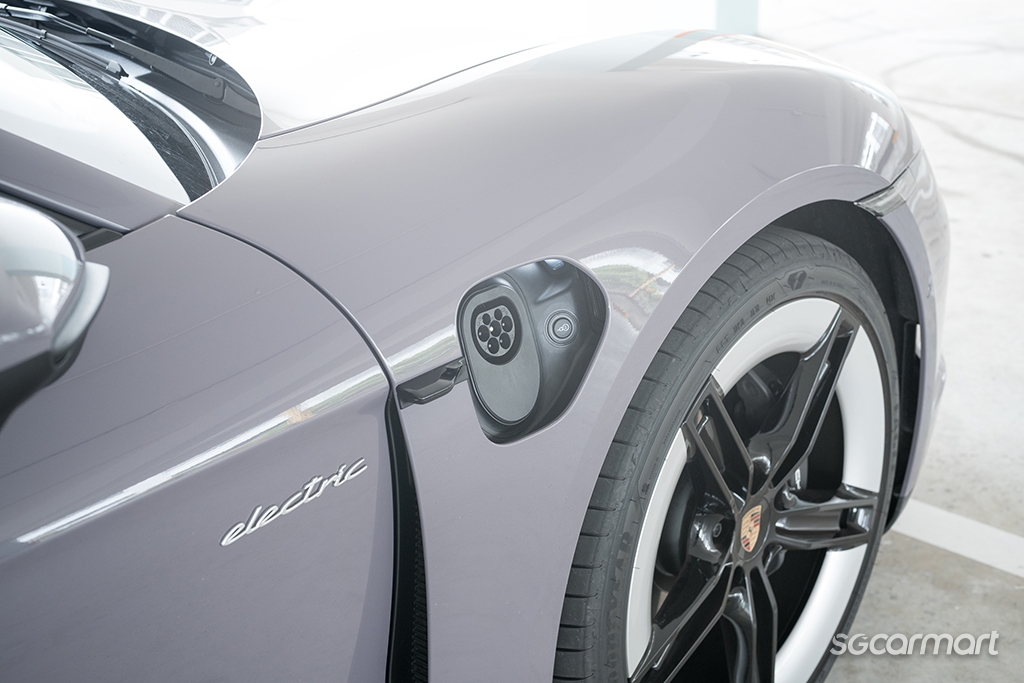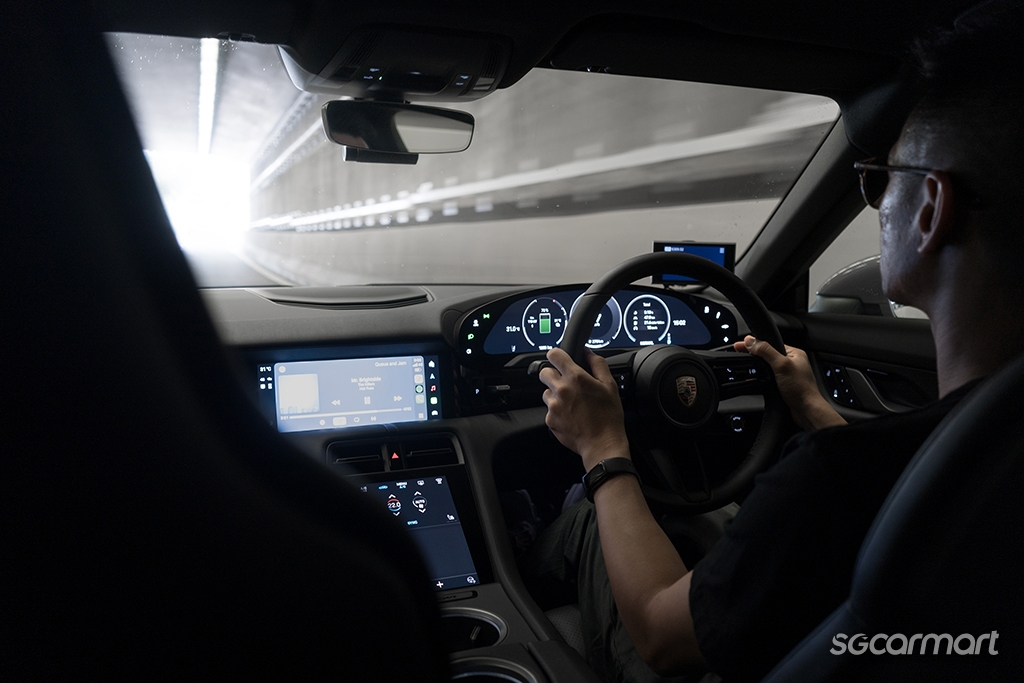Porsche Taycan Facelift Review
10 Oct 2024|7,296 views
Facelift (What's New)
Power increased by 80kW
Increased battery capacity offers more range
Air suspension as standard
Revised front-end
Higher level of standard equipment in the cabin
When Porsche unveiled the Mission E concept in 2015, it was met with a mix of awe and apprehension. It looked wild and decidedly futuristic, but the fact that it was electric caused quite a stir.
Almost a decade on, that apprehension towards electrification seems almost quaint. The automotive world has moved rapidly toward it, Porsche included.
And when the Taycan was eventually launched in 2019, those fears were largely unrealised. The Taycan was a revelation - electric, yes, but still very much delivering on Porsche's sports car DNA (and with a Porsche-appropriate price tag to match).
With this facelift, can the Taycan still stand out among a much more crowded field?
I love how the pre-facelift Taycan looked. This facelift brings with it some slight exterior updates - while the general shape is largely unchanged, redesigned air intakes actually accentuate the width of the car. Combined with the four-point signature within the standard Matrix LED head lights (which look wider, but I haven't measured it with a tape measure; Porsche does state in the press release that they are "flatter"), the result is a very notable sense of horizontal emphasis.
It makes the car look both wider and lower, and somehow I'm not convinced it looks better. Dimension-wise, the updated Taycan is a hair shorter in height but otherwise unchanged, so this is a visual change that, I don't know, I'm not convinced it actually needed. I like the pre-facelift look more.
At the rear, there's now the option of an illuminated 'Porsche' wording within the body-wide light strip. Completely unnecessary, but it looks great and fancy. The car you see here is also fitted with the optional $18,445 21-inch Mission E Design Wheels.
Equipment levels on the base Taycan have been increased, with features like the BOSE surround sound system and drive mode selector now coming as standard
Step inside the updated Taycan, and it looks, um, unchanged. Well, the hardware is effectively the same as before, except that some features (like the driving mode selector knob on the steering wheel) now come standard even on this base variant.
The infotainment interface has gotten a UI update, and it is more sleek and cleaner to operate than before. And you are going to have to use it quite often - important functions like adjusting the air-con vents are still digitally controlled (ugh).
Otherwise, it delivers expectedly Porsche quality and luxury, with the bonus of this base variant getting a range of equipment as standard now - BOSE surround sound system, 14-way adjustable comfort seats up front, comfort access, advanced 4-zone climate control, Park Assist. And as you'd expect, a long list of options will be available - this car is fitted with optional soft-close doors.
It is under the skin where there have been more notable revisions.
First is performance. Power on the single rear motor has been bumped up by 80kW to 300kW and 410Nm of torque, so with launch control activated 0-100km/h takes a very brisk 4.8 seconds (and this is the base variant. Lol). That's 0.6 seconds quicker than before.
Battery capacity has also gone up from 79.2kWh to 89kWh, and promises 566km on a full charge. Maximum charging power has also been bumped up from 270kW to 320kW, though good luck finding a charger powerful enough in Singapore. Porsche claims that under specific conditions, charging time could be halved. My experience with the car is that you'll need more time to recharge than it will. Moot point.
Air suspension comes as standard - giving you access to different damping settings, as well as adjustable ride heights
Also, all variants come standard with two-chamber air suspension - besides improving comfort, you can also adjust the ride height of the car (either manually, or with the different drive modes). It adds more breadth to this base Taycan's abilities.
The result of these changes… is more performance and polish on a familiarly-specific Taycan formula. And yes, it's fantastic. It's a treat to drive, with relatively communicative and sharp steering, and excellent ride stability and body control. It's exactly the Taycan you expect and want.
Charging power has also increased - a readout on the dashboard lets you know the maximum charging power possible (it varies depending on the battery state-of-charge)
Pushed hard, the Taycan feels alert and responsive, tackling corners with confidence and aggression. I particularly like the really low seating position - it's definitely sports car-like. Let off the go-pedal, though, and it calms down nicely. Highway drives are comfortable and fuss-free thanks to excellent ride pliancy, and it's just a delightful drive throughout.
Efficiency-wise, the 5.5km/kWh figure I clocked would translate to about 453km on a full charge. Considering the car was on and stationary a fair bit, and my lack of efficiency-oriented inclinations whilst driving, I'd say that's a pretty good number. The improvement is real.
Porsche touts this a "particularly extensive update" of the Taycan. That's perhaps true if you zoom out and look at the larger model range - the more fully-fledged variants get fancy new tech like the Active Ride suspension system, on top of more equipment, performance and range.
For this base variant, it's hard to call it extensive. While there have been some mechanical upgrades, many of the updates are also previously optional equipment being made standard. Thankfully, the price of the car hasn't really gone up (this base model starts at just under $400k without COE, so more or less the same as the pre-facelift model).
Which is to say that the updated Taycan feels familiar, and yet somehow you can make the case that you're getting slightly more value-for-money (if you can say that about any Porsche). It's an improved car, demonstrating more polish, but also a car that feels quite similar to before.
It also highlights just how much Porsche got it right the first time round. While there were (and still are) some gripes with certain UX decisions, there was no faulting the mechanical package that Porsche delivered with the original Taycan. This new one strays little away from it, because there was hardly anything that needed fixing. And that's my key takeaway - the improvements here may not feel very significant, but that's because the original car was so good to begin with.
EV options have expanded greatly since the Taycan was originally launched in 2019, but this facelifted model continues to set the high bar as far as driveability is concerned. Yes, it’s (still) expensive as heck, and may not have the most in terms of equipment and technology, but the Taycan delivers a particular kind of driving experience (and badge recognition) that is deeply appealing.
Sure, the headliner may be the new 1,000bhp Taycan Turbo GT, but hand on heart, this base-variant Taycan is the one that I would want.
Here are some other electric four-door sports sedans to consider:
The BMW i4 delivers a sweet drive thanks to a well-judged ride-handling balance
Facelift (What's New)
Power increased by 80kW
Increased battery capacity offers more range
Air suspension as standard
Revised front-end
Higher level of standard equipment in the cabin
When Porsche unveiled the Mission E concept in 2015, it was met with a mix of awe and apprehension. It looked wild and decidedly futuristic, but the fact that it was electric caused quite a stir.
Almost a decade on, that apprehension towards electrification seems almost quaint. The automotive world has moved rapidly toward it, Porsche included.
And when the Taycan was eventually launched in 2019, those fears were largely unrealised. The Taycan was a revelation - electric, yes, but still very much delivering on Porsche's sports car DNA (and with a Porsche-appropriate price tag to match).
With this facelift, can the Taycan still stand out among a much more crowded field?
I love how the pre-facelift Taycan looked. This facelift brings with it some slight exterior updates - while the general shape is largely unchanged, redesigned air intakes actually accentuate the width of the car. Combined with the four-point signature within the standard Matrix LED head lights (which look wider, but I haven't measured it with a tape measure; Porsche does state in the press release that they are "flatter"), the result is a very notable sense of horizontal emphasis.
It makes the car look both wider and lower, and somehow I'm not convinced it looks better. Dimension-wise, the updated Taycan is a hair shorter in height but otherwise unchanged, so this is a visual change that, I don't know, I'm not convinced it actually needed. I like the pre-facelift look more.
At the rear, there's now the option of an illuminated 'Porsche' wording within the body-wide light strip. Completely unnecessary, but it looks great and fancy. The car you see here is also fitted with the optional $18,445 21-inch Mission E Design Wheels.
Equipment levels on the base Taycan have been increased, with features like the BOSE surround sound system and drive mode selector now coming as standard
Step inside the updated Taycan, and it looks, um, unchanged. Well, the hardware is effectively the same as before, except that some features (like the driving mode selector knob on the steering wheel) now come standard even on this base variant.
The infotainment interface has gotten a UI update, and it is more sleek and cleaner to operate than before. And you are going to have to use it quite often - important functions like adjusting the air-con vents are still digitally controlled (ugh).
Otherwise, it delivers expectedly Porsche quality and luxury, with the bonus of this base variant getting a range of equipment as standard now - BOSE surround sound system, 14-way adjustable comfort seats up front, comfort access, advanced 4-zone climate control, Park Assist. And as you'd expect, a long list of options will be available - this car is fitted with optional soft-close doors.
It is under the skin where there have been more notable revisions.
First is performance. Power on the single rear motor has been bumped up by 80kW to 300kW and 410Nm of torque, so with launch control activated 0-100km/h takes a very brisk 4.8 seconds (and this is the base variant. Lol). That's 0.6 seconds quicker than before.
Battery capacity has also gone up from 79.2kWh to 89kWh, and promises 566km on a full charge. Maximum charging power has also been bumped up from 270kW to 320kW, though good luck finding a charger powerful enough in Singapore. Porsche claims that under specific conditions, charging time could be halved. My experience with the car is that you'll need more time to recharge than it will. Moot point.
Air suspension comes as standard - giving you access to different damping settings, as well as adjustable ride heights
Also, all variants come standard with two-chamber air suspension - besides improving comfort, you can also adjust the ride height of the car (either manually, or with the different drive modes). It adds more breadth to this base Taycan's abilities.
The result of these changes… is more performance and polish on a familiarly-specific Taycan formula. And yes, it's fantastic. It's a treat to drive, with relatively communicative and sharp steering, and excellent ride stability and body control. It's exactly the Taycan you expect and want.
Charging power has also increased - a readout on the dashboard lets you know the maximum charging power possible (it varies depending on the battery state-of-charge)
Pushed hard, the Taycan feels alert and responsive, tackling corners with confidence and aggression. I particularly like the really low seating position - it's definitely sports car-like. Let off the go-pedal, though, and it calms down nicely. Highway drives are comfortable and fuss-free thanks to excellent ride pliancy, and it's just a delightful drive throughout.
Efficiency-wise, the 5.5km/kWh figure I clocked would translate to about 453km on a full charge. Considering the car was on and stationary a fair bit, and my lack of efficiency-oriented inclinations whilst driving, I'd say that's a pretty good number. The improvement is real.
Porsche touts this a "particularly extensive update" of the Taycan. That's perhaps true if you zoom out and look at the larger model range - the more fully-fledged variants get fancy new tech like the Active Ride suspension system, on top of more equipment, performance and range.
For this base variant, it's hard to call it extensive. While there have been some mechanical upgrades, many of the updates are also previously optional equipment being made standard. Thankfully, the price of the car hasn't really gone up (this base model starts at just under $400k without COE, so more or less the same as the pre-facelift model).
Which is to say that the updated Taycan feels familiar, and yet somehow you can make the case that you're getting slightly more value-for-money (if you can say that about any Porsche). It's an improved car, demonstrating more polish, but also a car that feels quite similar to before.
It also highlights just how much Porsche got it right the first time round. While there were (and still are) some gripes with certain UX decisions, there was no faulting the mechanical package that Porsche delivered with the original Taycan. This new one strays little away from it, because there was hardly anything that needed fixing. And that's my key takeaway - the improvements here may not feel very significant, but that's because the original car was so good to begin with.
EV options have expanded greatly since the Taycan was originally launched in 2019, but this facelifted model continues to set the high bar as far as driveability is concerned. Yes, it’s (still) expensive as heck, and may not have the most in terms of equipment and technology, but the Taycan delivers a particular kind of driving experience (and badge recognition) that is deeply appealing.
Sure, the headliner may be the new 1,000bhp Taycan Turbo GT, but hand on heart, this base-variant Taycan is the one that I would want.
Here are some other electric four-door sports sedans to consider:
The BMW i4 delivers a sweet drive thanks to a well-judged ride-handling balance
Thank You For Your Subscription.
- Visible Updates
- Electric Upgrades
- Stellar Formula






































































